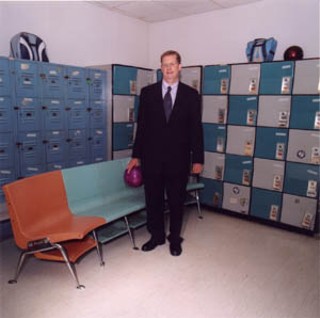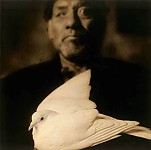Talking Art at the Top
The executive directors of the city's museums shed light on the local visual arts scene
By Sam Martin, Fri., July 2, 2004

If you didn't know, the Austin Museum of Art is not going to build its new downtown facility at Fourth and Guadalupe. The reasons are numerous, but the ultimate deal breaker was the fact that even if AMOA had succeeded in raising the $43 million it would've taken to build the 250,000-square-foot Richard Gluckman design, it would still need $9 million a year just to operate it. That's more than three times the cost of running the present downtown space and the Laguna Gloria estate combined. Says Dana Friis-Hansen, AMOA executive director: "Our eyes were bigger than our stomachs."
So where does that leave AMOA, and more importantly, where does that leave visual art in Austin? There's no doubt that a city museum for Austin is a valuable and necessary cultural institution. Where else are we going to see an Andy Warhol retrospective? It's also true that a museum downtown can help spur along our sluggish economy by attracting tourists and providing employment. Yet to peg the local art scene to the rise and fall of one museum space (or lack thereof) isn't realistic and isn't an honest look at the whole picture.
The fact is, the visual arts community in Austin is having the most vibrant and productive period of its history. In the past five years, literally dozens of alternative and experimental gallery spaces have opened in town. Established galleries have welcomed a growing crowd of collectors. Arthouse has managed to become debt-free, while Mexic-Arte Museum is enjoying its new official status as the Mexican and Mexican American Fine Art Museum of Texas. And although we won't have a new AMOA building, we do still have its present space downtown as well as a newly renovated Laguna Gloria. Plus, let's not forget about the University of Texas' new home for the Blanton Museum of Art, which will house the largest university visual-art collection in the country.
What this amounts to is tens of thousands of square feet in which to display and discuss art, popular culture, and history. The question, then, shouldn't be: What are we going to do without more space? The question should be: How are these places going to stay open?
Money is always a concern, especially these days. But more crucial to the persistence of a lively visual arts community are the people involved in it. Artists are essential, of course, but they're not always great at promoting their own work. Of equal importance are the curators, museum directors, gallery owners, and anyone else making decisions about the organization and promotion of art shows. Without knowing these people, we wouldn't be able to sketch an accurate profile of the local scene. This article launches a series of features in which we help you get to know some of those decision makers in Austin's visual arts community.
Dana Friis-Hansen, Arthouse executive director Sue Graze, and Mexic-Arte executive director Sylvia Orozco are the decision makers behind one section of Austin's art community: its museums. As they tell it, art in Austin is more than the sum of its parts. Their museums have crucial roles to play in not only educating the larger community with art but also actively supporting local artists. To know these people is to begin to know how Austin's art world ticks.
Art Ecosystems
Dana Friis-Hansen (pronounced "Freeze-Hansen") is bright-eyed and energetic, and the glass of life that he drinks from is, by his own admission, always half-full, not half-empty. His official title is the Dr. and Mrs. Ernest C. Butler Executive Director, which seems long for someone at the young age of 42. Nevertheless, the Massachusetts-born administrator has embraced the job that he was thrust into three years ago after previous director Elizabeth Ferrer resigned suddenly. There's a good chance that no one in town is more disappointed about the new space not getting built. Yet with unflagging optimism he registers his complaint and turns immediately to what the museum is doing.
"Everything was very rosy until the bubble burst, and then we realized that what had been planned when the NASDAQ was at 5000 was not feasible when the NASDAQ tanked," he says. "But when life gives you lemons, you make lemonade. The fact is, Austin has a downtown art museum."
By the looks of it, that museum is doing well. On the Wednesday morning I spoke with Friis-Hansen, the galleries were positively bustling with schoolchildren and summer camp groups sitting in circles on the floor gesturing at the art on the walls as other visitors and individuals took long looks at the current exhibition, "Books and Parts of Books," featuring work by Austin artist Lance Letscher.
Also, the museum is in the best financial shape in years. After scrapping its plans for the new building, AMOA managed to eliminate its deficit and is now "in the black." Friis-Hansen has just hired a new curator. Resources are being spent on art education and locally curated exhibits by artists from Austin and around the state (and attendance is strong). Instead of being saddled with the pressure of having to run and afford a museum that was too big for the museum at present, the AMOA staff and board can focus their energies on the mission that has been seemingly overshadowed for years by the dream of a bigger, better space: to educate the community with new and exciting art while supporting local artists.
That last bit, the one about supporting local artists, may come as a surprise to many. But it is a crucial part of Friis-Hansen's total vision for this Austin museum.
"An art scene is an ecosystem with many parts to it," he explains. "And each of these parts must work together in order for the ecosystem to thrive. Museums and galleries can play a role by showing local artists' work, and at the same time artists can support themselves by working at the museum as truckers, packers, and art hangers. In other words, we want to create an incentive for artists to stay in Austin. Why would they stay if there's no place to show, no place to get a job, no critical writing about their work, et cetera? Why create your work in a vacuum?"

In fact, one of the most successful shows the museum has ever had was Friis-Hansen's brainchild. The April 2002 exhibit "22 to Watch" gave 22 artists from Central Texas (officially they had to live within a 50-mile radius of Austin) the attention the director believes they deserve. He plans to organize the show every three years. The next one is planned for the fall of 2005, after which it will head to museums in Galveston and Dallas. Says the director: "We'll be exporting Austin artists as well."
Friis-Hansen's passion for art and artists can be traced back to his university days at Carlton College in Minnesota, where he earned a B.A. in art history. During his junior year, he was the Helena Rubenstein Fellow at the Whitney Museum of American Art Independent Study Program. From 1985 to 1991, he was curator at MIT's List Visual Art Center, then moved to Tokyo to work as a curator at a private firm. His last job before moving to Austin in 1999 to become chief curator at AMOA – a job he still officially has – was senior curator at the Contemporary Arts Museum Houston.
Now, of course, he loves living in Austin. His downtown loft is close to the office and near the action. He's also an avid swimmer and starts most days bright and early at Barton Springs.
"One of the reasons I enjoy shaping the direction of the museum is that the people in Austin are curious, intelligent, and engaging, with many different interests. What we want to do at AMOA is welcome and serve the full range of people with different art and museum experiences. Austin has never had an ongoing serious museum culture, and I'm excited about helping to bring that about."
As the Museums Go, So Go Our Artists
Across the street and one block south of AMOA-Downtown, Sue Graze, the exuberant director of Arthouse, can relate. When she came to town five years ago, after working for 10 years as a curator at the Dallas Museum of Art and two years as senior curator at the Miami Art Museum, she wasn't encouraged by what she saw.
"My initial response when I was asked to take the job was, 'Are you crazy?!'" she says before breaking into a booming laugh. "At the time, the visual arts were not a significant part of the community, not like they were in Miami or Dallas."
But like Friis-Hansen, Graze has committed herself and Arthouse to making visual art in Austin more prominent – with significant success.
After growing up on Long Island, Graze went to the University of Wisconsin-Madison, graduating in 1970 with a degree in English, even though her real passion was art history. After taking an extra semester's work of undergraduate courses, she went to the University of California, Riverside to get a master's degree in that field. When she left Riverside, she took an internship at the DMA and ended up staying for 14 years as curatorial assistant, registrar, assistant curator, and finally curator of contemporary art. She taught for a few years before becoming senior curator in Miami. In 1998 she was approached to run Arthouse, which had just opened its present location and was still known as the Texas Fine Arts Association.
Since then Arthouse has become a valuable partner in Austin's visual arts community by supporting local artists when it can and offering a diverse range of work to fill what is considered by many to be the most sophisticated gallery space in town.
"We're the only organization that is 100 percent committed to showing cutting-edge contemporary art in the city," Graze says. "And even though our core community is Texas as a whole, we have an important role to play in Austin."
Interestingly, Arthouse and AMOA have very closely intertwined pasts. The Texas Fine Arts Association – as Arthouse has been known for most of its long life – was started in 1911 by a group of amateur women artists with the singular goal of caring for the studio and work of legendary Austin sculptor Elisabet Ney. Soon, though, the group helped initiate UT's studio art program while putting on shows of Texas artists all over the state. Eventually, the Elisabet Ney Museum was deeded to the city, and in 1943 philanthropist Clara Driscoll, who was a member of TFAA, donated her estate to the group with the stipulation that it be made an art museum. That became the Laguna Gloria Art Museum, which separated from TFAA in 1961. Five years later, TFAA deeded the property to Laguna Gloria, which later changed its name to the Austin Museum of Art.
These days, the two museums still have similar agendas, at least in terms of the way Graze and her AMOA counterpart view local artists and the role museums should play in the greater Austin art scene.

"Our main constituency is always artists, and if the shows we're doing aren't bringing in artists, then that's no good," Graze explains. "We try to work with local artists as much as possible because we're well-aware that for the art scene here to continue to grow, we have to have a city where artists can live and work and become recognized in some way."
Like Friis-Hansen, Graze likes to employ local artists when she can. (Arthouse has four full-time staff members in addition to Graze and six part-time employees.) She thinks that the more successful the galleries and museums are, the more successful the city's artists will be.
As far as financial stability goes, Arthouse has managed to sail through the recent economic doldrums with apparent ease. After paying off the mortgage on its building in 2002, the organization has been operating debt-free with the help of what Graze calls "generous donors." Arthouse is ready to expand into the upstairs part of its gallery and has just posted a call for architects. The tentative plan is to create more gallery space along with artists' studios so the museum can create an ongoing yearlong artist-in-residence program for three Texas artists.
"Our artists are our seers and our prophets, and if we can't do something for them, then we need to be closing," says Graze.
The Old Guard
If anyone knows about the plight of the working artist, it's Sylvia Orozco, who opened Mexic-Arte with her ex-husband, artist Pio Pulido, and local artist and art teacher Sam Coronado in 1984 because there was no one in town who would display their paintings. Twenty years later, Orozco is still showing art, just not her own (although she still paints when she finds the time). In a nod to the museum's staying power and its value to the city and state, Gov. Rick Perry recently bestowed the space with the title of Official Mexican and Mexican American Fine Art Museum of Texas.
"Our role is a little different than the other museums in town in that we have commitment to the growing Latin and Mexican community by exploring our cultural history and showing contemporary art," says Orozco. "But like the other museums in Austin, we have a general commitment to presenting art, supporting artists, and educating the public."
Born to a Guadalajaran boot maker, Orozco grew up in Cuero, Texas, where she was the family artist from a young age. Long before she came to the capital city to study painting, she was drawing her brother's and sister's science projects and designing the bulletin board at school. After graduation from UT-Austin, she quickly discovered that no one was interested in the paintings of a young Latina abstract expressionist.
"Lots of artists in the Seventies and Eighties were creating their own alternative spaces because they were being rejected by the museums or they weren't allowed to actively participate," says Orozco. "And if you were Latino and wanted to explore Latino themes, it was worse because there weren't even any museums to get rejected by."
Now, Mexic-Arte is keenly aware of the need to support artists, in addition to bringing unusual and rare Mexican art to Austin. Its Young Latino Artists series (which recently closed its ninth annual exhibition) helps emerging artists from around Texas get a serious museum show under their belts. Mexic-Arte also sponsors an artist-in-residency program in which they pay professional midcareer artists to teach a two-week course on Latino art in schools throughout the state. This year's artist is accomplished local painter Fidencio Duran.
The museum has a similar program for local elementary schools. The courses are eight weeks long and they're taught by local artists. Like Friis-Hansen and Graze, Orozco knows an art institution is nothing without artists to fill its walls.
Orozco is also keenly aware of what it takes to keep an art space open and running, having weathered not only this last economic downturn but the one in the late Eighties, as well.
"We're famous for doing a lot with a little, though I'd rather that was leveled out a bit," she says with a smile. "By now though I think the city recognizes and the people recognize that they need Mexic-Arte and that we do a good job. We also have a good board that helps us raise money."
Still, like her colleagues at AMOA and Arthouse, Orozco knows that for the arts community in Austin to continue to grow, its institutions cannot rest on their laurels. In that spirit, Mexic-Arte has recently renovated its museum store and stocked it with fresh goods, such as hip urban gear from Mexico City and beautiful handmade jewelry by regional and Mexican artists. The museum has also received a $100,000 grant from the Houston Endowment to explore the idea of constructing a new building on the site of the old one.
"We're not here today, gone tomorrow," says Orozco. "We are about the future."
AMOA's Friis-Hansen and Arthouse's Graze couldn't have said it any better. ![]()








